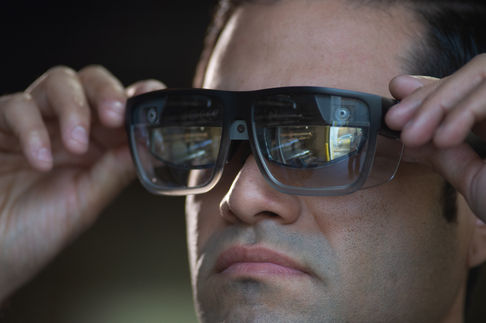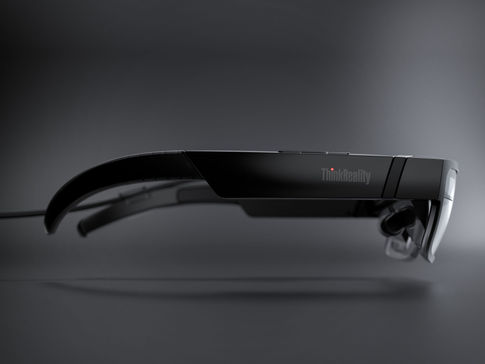
Lenovo
Designing the Most Versatile Lightweight Smart Glasses Ever Made for Enterprise
2019 - 2021 | Design Manager
In 2019, we started work on own second AR solution, the ThinkReality A3. These lightweight smart glasses would be the first commercial-grade solution in the market and be designed specifically for employee productivity.
I led the multi-disciplinary team that brough the ThinkReality A3 to market. The hardware design has won multiple global awards and recognitions.
Business Objective
Design premium lightweight smart glasses that exceed ergonomics and usability expectations to extend usage across various groups.
Design Objective
Provide UX leadership and HF support to help the team develop AR glasses that will fit comfortably across a diverse set of users.





DESIGNING DIVERSE TECHNOLOGIES

BACKGROUND
Our experience designing Mixed Realty (MR) products has grown significantly since our first product launch, the ThinkReality A6. With more experience, it was time to tackle our next MR solution.
The need was for a commercial-grade lightweight smart glasses that could easily be donned on and off depending on user tasks. The flexibility of being portable would extend to various use cases from daily in-office work to work during travel. Since our use cases and target customers were still fluid, our UX team started with the most basic user tasks.
In 2019, we set out on a journey to design the first lightweight smart glasses built for the enterprise.
DESIGN TEAM
In the beginning, we worked closely with ID and R&D to come up with user scenarios that would differentiate the A3 from the A6. From here, I defined what technical skills and experience we would need to execute the design. Designing a wearable device was significantly different from what we had done before. Facial anatomy is arguably the most complicated part of the human body.
I recruited two human factor engineers and two user researchers. They worked closely with others on my team including UX designers and UX prototypers to ensure we designed this holistic user experience together. Other teams at Lenovo separated these functions into silos but I knew we had to be different for this project. This was the most critical aspect in creating a new and emerging technology from the ground up.
INNOVATION WORKSHOP
We first started with a brainstorm session that involved all the key stakeholders. We knew we had to take the lead so that design was at the forefront of everyone's mind so we hosted the session and invited the executive leadership.
SETTING THE MVP
This innovation workshop was held before Project Kick-Off (PKO), our formal kick off process for any new product. The goal of the workshop was to agree on the MVP features and understand what key areas would be critical to get right.
We split the workshop into several segments spanning a few days. Segments included hardware, software, and marketing and business strategy. There were many important technical decisions we made early on such as what optical engine we would use, what compute source we needed, and design targets like overall weight and temple temperature.
COMPETITOR BENCHMARKING
One of the early activities we did was buy up every AR device on the market. We built an internal lab where we reviewed all these devices, creating separate competitor benchmarks for each device. These insights allowed us to set aggressive design targets such as getting our overall weight under 100g and keeping the device temperature as cool as possible, especially in extreme conditions.


These are a couple of examples of our extensive benchmark reports. For each report, a detailed analysis of the product is conducted. We review the ergonomics, fit, usability, key features, and other important aspects of the design. We cover both hardware and software experiences in our reports.
We also provide a detailed matrix of how we rank and rate each of these competitor products against each other. We established usability metrics and then plot the scores against the web graph. Key specifications are taken into account and an overall UX score is given.


EARLY MOCKUPS
We worked closely with the ID team to rough out a few early form factors and 3D printed them to get an idea of their size and weight. We created these prototypes with roughed out areas for the optical engine, which takes up most of the HMD space.
We knew that if we wanted users to wear these glasses everywhere, they needed to look as normal as possible. Feedback from customers noted that large HMDs created stigmas in certain industries like healthcare so the design needed to be friendly and approachable.

MAPPING MECHANICS
Some initial form factors were sculpted based on where the internal mechanics would be. We quickly carved out these forms so we could get a sense of where we were with fit and function. The biggest challenge was where the glasses would sit on the face and how we could make it comfortable for all different types of facial features.





DETAILED DESIGN
There were several parts of the device that needed a lot of human factors support, starting with temple fit. Users would wear these devices for a long extended period of time so we knew we had to make them comfortable. The challenge was how to make them comfortable for all different head shapes and sizes.



TEMPLE CURVATURE AND SPRING FORCE
After researching various literature on head size anatomy, we took our best guess on what the correct temple length, curvature, and size should be to fit all head sizes comfortably. Then, we altered these dimensions slightly and printed off various mockups to test with real users.
We brought in 3D head scans sourced from the CEASAR dataset and ran analyses to find rough dimensions for the temple end curves.


IMPACT OF COVID-19
We had only been working on the project for two months before we were asked to shelter-in-place. This proved to be the single most significant challenge to our project. We had to design a wearable device without having access to in-person testing.
We got creative, using family and friends and colleageues who worked in countries with less restrictive measures like China. Over the course of the project, we got really good at getting quick user feedback with limited access. This was partly because we identified individuals who sat at the extreme ends of the antropometric scales.
TEMPLE CURVATURE AND NOSE PIECE
We also acknowledged the difficulty of getting the right balance between the temple end force and the nose piece design. Therefore, the temple end design, the temple end force, and the nose piece design had to all work together to make the headset feel comfortable to wear. This balance showed up time and again in each of our user research studies.
USER TESTING
Throughout the project, we ran over 60 user studies with over 1000 data points. What we quickly found out was that we needed more flexibility between the three areas above so we designed various iterations and tested them with a diverse range of users.


This is one example of a user study we ran with N=10. We measured everyone's head sizes and asked them to try on several temple end designs that varied by length, curvature, and force.


In this study, we found that Asian participants had the biggest trouble finding the right combination of temple length, curvature, and force. Also, they struggled with finding the right nose piece design that would fit comfortably and also allow them to see their FOV correctly.

We also took notes on how well the curvature wrapped around the head and correlated this information with the user's preferred choice. As you can see in this image, there is an air gap if the temple is too short. However, if the temple is too long, it feels more loose.
We also found some participants to express some pain and discomfort on where the temple end rested on the head. There is a few soft areas on the back of the head we were trying to avoid since they are more sensitive to pressure.

Temple End preference test results showed a distribution amongst our participant pool.

Nose Piece preference test results showed a preference for Nose Piece 3, however, the findings were not significant as some users really loved Nose Piece 1 and 2.
The biggest challenge in designing a wearable device is that you have one chance to get it right with all users. That's almost impossible to do without some sort of flexibility.
HF SPECIFICATION
Combining the information from academic research with the results of all our user testing, we created an Human Factors Specification that detailed out all the important information for our product.

The specification included anything related to human factors engineering like temple end designs, audio requirements, nose piece design, weight, temperature recommendations, and more.
FLEXIBILITY IS KEY
Based on all the information we had gathered, our position was simple - we must provide users with flexibility when it comes to comfort and fit. The only way we could accomplish this was to provide multiple versions of the temple ends and nose pieces to select from.
I pitched this idea to the leadership team and it was approved. I knew we wouldn't be able to make a great wearable device without providing these finer adjustments. We knew it would also be key to a much better user experience - something that other competitors hadn't done before.

THERMALS
One of the most difficult parts of the project was setting the right expectations when it came to the device's thermals. The engineering team's initial simulations had shown the device was would be above our temperature requirements.
We collected and read hundreds of thermal papers trying to find a way to reduce the heat outputted by our device, especially to areas that would touch the user's skin. This was primarily the forehead, but we also made sure that the hinges and top surface were cool enough to touch as the user may interact with these areas when donning on and off the glasses.
Each week, I stressed the importance of hitting these targets, even though the engineering team tried to convince leadership they were within industry specifications. It became one of the most difficult things I had to champion on this project admist a ton of other features and elements.




DESIGN WITH PERSISTENCE
Finally, after several months of simulations and prototypes, the engineering team finally found a mechanical solution to reduce the heat to meet our specification. If we had given in to the higher temperature earlier, we wouldn't have decreased the temperature and improve the experience. There were a number of times during the project I had to reject the current solution because it didn't meet our UX requirement.

THE DESIGN
After months of iterations and user testing, we froze the design and launched ThinkReality A3 in the summer of 2021. It was an amazing effort from many cross-functional teams to produce such an innovative product in such an aggressive timeframe.

DEFINING SUCCESS
One of the most important aspects to creating such an innovative product was having a centralized design team. My team supported the hardware design, software design, and was responsible for all the user research. By working seamlessly together, we were able to stay nimble, communicate important information, and pivot quickly when needed.
For example, when the team shifted away from a dedicated compute pack to the Motorola G100, we were able to address the hardware changes with software features. There were many instances where having a multi-disciplinary team proved to be the most effective way of tackling a challenge.
Our product design has been recognized with several global design awards including Red Dot, iF Award, and Time Magazine's Best Inventions of 2021.










































